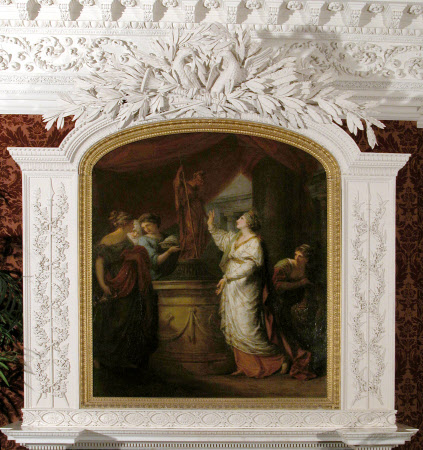Penelope sacrificing to Minerva for the Safe Return of her Son, Telemachus
Angelica Kauffman RA (Chur 1741 – Rome 1807)
Category
Art / Oil paintings
Date
1774 (signed and dated)
Materials
Oil on canvas
Measurements
1499 x 1264 mm (59 x 49 3/4 in)
Place of origin
England
Order this imageCollection
Stourhead, Wiltshire
NT 732292
Caption
Penelope, accompanied by her attendants, is invoking the aid of Minerva (or Athene), represented by a statue standing on a round plinth. Telemachus, accompanied by Minerva, disguised as his old guardian Mentor, had set out to find his father, Ulysses, after he did not return home from the Trojan wars but he also got waylaid and his mother is praying for his return. The scene is told in Homer’s Odyssey but the artist may have been using François Fénélon’s Les Aventures de Télémaque, published in 1699 as a source when she painted the picture in 1774.
Summary
Oil painting on canvas, Penelope sacrificing to Minerva for the Safe Return of her Son, Telemachus by Angelica Kauffmann RA (Chur 1741 – Rome 1807), signed and dated: Angelica Kauffmann pinx: 1774, exh. RA 1774 (no. 143). Penelope stands at right, wearing white and gold robes, invoking the aid of Athene or Minerva, represented by a statue standing on a round plinth in the centre of the composition with attendants on either side. The scene depicted comes from the the Greek poet Homer's Odyssey, Book 4.
Provenance
Brought from Wavendon by Sir Henry Hugh Arthur Hoare 6th Bt (1865 - 1947) and Alda Weston, Lady Hoare (d. 1847) between 1894 and 1898/or after the fire of 1902. Given to the National Trust along with the house, its grounds, and the rest of contents by Sir Henry Hugh Arthur Hoare, 6th Bt (1865 – 1947) in 1946.
Credit line
Stourhead, The Hoare Collection (National Trust)
Makers and roles
Angelica Kauffman RA (Chur 1741 – Rome 1807), artist
References
The London Chronicle, 3 May 1774 Lady Victoria Manners and G. C. Williamson, Angelica Kauffmann, 1924, p.191 Irwin 1966 David G. Irwin, English Neo-Classical Art;studies in inspiration and taste, London 1966 , p.88, pl.108.

